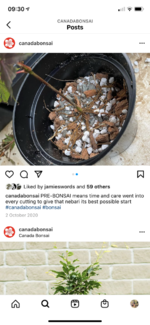The Ficus Guy
Seedling
- Messages
- 22
- Reaction score
- 33
Hey all,
So I've been doing a lot of reading on creating nebari on trees early on, and I've read of a couple of different techniques. One is the classic method of threading the seedling/cutting through a washer. The other is to plant the seedling/cutting/young tree on a tile to grow. Has anyone tried both methods and can attest to the results of either?
I have some Ficus that need to be trimmed real bad, and want to see if there's anything I can do to help them get started on the right footing in terms of nebari and a decent base.
Thanks in advance!
TFG
So I've been doing a lot of reading on creating nebari on trees early on, and I've read of a couple of different techniques. One is the classic method of threading the seedling/cutting through a washer. The other is to plant the seedling/cutting/young tree on a tile to grow. Has anyone tried both methods and can attest to the results of either?
I have some Ficus that need to be trimmed real bad, and want to see if there's anything I can do to help them get started on the right footing in terms of nebari and a decent base.
Thanks in advance!
TFG


